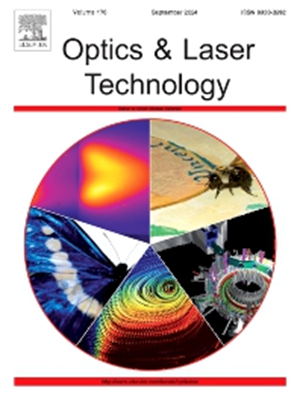A novel in situ laser cladding technology incorporating an underwater air chamber for the manufacturing of 316 coating
IF 4.6
2区 物理与天体物理
Q1 OPTICS
引用次数: 0
Abstract
Marine equipment faces significant maintenance challenges due to the inability to extract components from the marine environment for repair. Over the past decade, laser cladding technology has experienced rapid development as a method for repairing key parts of ships. However, the direct application of underwater laser cladding for in situ repair remains an area requiring further exploration. This study introduces the development of an innovative air chamber laser processing head and, for the first time, presents an in situ laser repair technology called Underwater Directed Energy Deposition with Air Chamber (UDED-AC). The behavior of the underwater air chamber was analyzed using the Young-Laplace equation and the Rayleigh-Plateau instability principle, elucidating its influence on the cladding process. Additionally, a comparative analysis of the morphology and properties of 316 coatings fabricated in air and underwater environments was conducted. The results indicate that using UDED-AC in situ additive manufacturing technology leads to a deeper molten pool in the underwater environment compared to air. Moreover, the increased precipitation of SiO2 particles within the dendrites enhances the hardness of the cladding layer prepared underwater. Meanwhile, the corrosion resistance and wear resistance of the deposited layers show no significant differences between underwater and air-prepared samples. The UDED-AC technology uniquely integrates the flexibility of underwater wet cladding with the precision of local drainage cladding, offering a transformative approach for underwater in-situ repair. This innovation holds significant promise for the repair and maintenance of marine equipment in challenging environments.
求助全文
约1分钟内获得全文
求助全文
来源期刊
CiteScore
8.50
自引率
10.00%
发文量
1060
审稿时长
3.4 months
期刊介绍:
Optics & Laser Technology aims to provide a vehicle for the publication of a broad range of high quality research and review papers in those fields of scientific and engineering research appertaining to the development and application of the technology of optics and lasers. Papers describing original work in these areas are submitted to rigorous refereeing prior to acceptance for publication.
The scope of Optics & Laser Technology encompasses, but is not restricted to, the following areas:
•development in all types of lasers
•developments in optoelectronic devices and photonics
•developments in new photonics and optical concepts
•developments in conventional optics, optical instruments and components
•techniques of optical metrology, including interferometry and optical fibre sensors
•LIDAR and other non-contact optical measurement techniques, including optical methods in heat and fluid flow
•applications of lasers to materials processing, optical NDT display (including holography) and optical communication
•research and development in the field of laser safety including studies of hazards resulting from the applications of lasers (laser safety, hazards of laser fume)
•developments in optical computing and optical information processing
•developments in new optical materials
•developments in new optical characterization methods and techniques
•developments in quantum optics
•developments in light assisted micro and nanofabrication methods and techniques
•developments in nanophotonics and biophotonics
•developments in imaging processing and systems

 求助内容:
求助内容: 应助结果提醒方式:
应助结果提醒方式:


